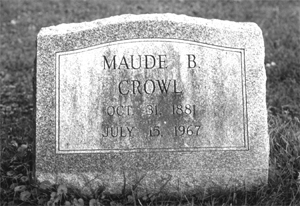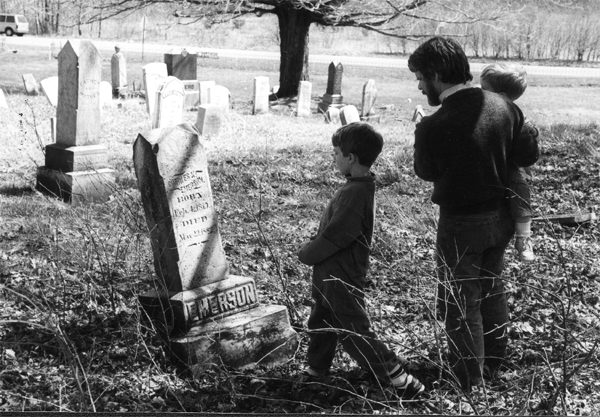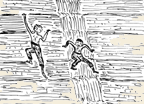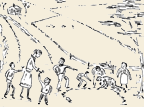|
The Call of Stories
by
Story 4
A Trip to Hope Cemetery in Campbell, in Late November 1990
With barely half an hour of daylight remaining, I exited the four-lane
and soon reached Hope Cemetery in Campbell. All afternoon I had agonized
over my decision to come. "I want to make the trip," said one voice inside
me. "But you have too much to do," said another. Finally, above Bath,
I heard on the radio a song from the 1970s:
So put me on a highway
And show me a sign
And take it to the limit
One more time.1
Somehow that settled the matter. My work in Rochester would just have
to wait. Ahead lay a new challenge: could I find the grave of Grandma's
other sister, Maude, before it got dark?
I began on familiar ground, in the section where Grandma is buried. Already
grass had grown over the raw earth, and a date of death—11 January
1990—had been carved on the stone she shares with her husband. Nearby
was the Beard stone, for her parents, and closer toward the road was a
stone for her eldest son, my Uncle Ed (Aunt Dotty's first husband).
From there I set out in earnest. Based on experience, I knew to be systematic.
"Up one row, down the next, look at each stone in turn," I coached myself.
That method, though effective, can be slow. Far sooner than expected,
however, I found the stone I sought:

In the fading twilight I wandered a while, not really sure what to do
next. Small flags, flapping in the breeze, were mounted in metal plaques
next to some of the stones. They, along with the closely-cut grass, testified
to how well the grounds were maintained-which would have pleased Grandma,
after her years of service in the cemetery association. By contrast, the
Wood Farm Cemetery had "gone wild." Its tombstones still linked information
to the mortal remains below. But the cemetery was no longer a human institution
in any active sense.
Between those extremes lay the cemetery at South Bradford. Located near
the farm on the hill where Grandma had grown up, the site had once boasted
two churches. One had burned down, while the other had been dismantled
for its lumber. Now only the cemetery remained.
I had taken my brother Don and his boys there, when they visited me the
spring after Grandma's death, and we located the tombstone for Charles
Kent Emerson and his wife. It had settled at an odd angle and brush was
growing up around it. But the area remained open enough for me to take
a picture-showing Brian, Don, and Justin:

In effect, then, what I had accomplished on my trips was to tie one of
Grandma's genealogical lines of descent to the appropriate series of tombstones.
Starting with the grave of Grandma's parents in the Campbell cemetery,
the line jumped to her mother's parents in the South Bradford cemetery.
From there it jumped to her mother's father's parents in the Wood Farm
Cemetery, near Tyrone. Beyond that, it jumped out of state—to New
England—where it continued, generation after generation, until it
reached the horizon of Grandma's research, namely, the Atlantic crossing
from Europe.
Story 5
A Return Trip to the Wood Farm Cemetery, in March 1991
On my second visit to Aunt Sarah's grave—in March 1991—I
came in the company of my friend, who had flown to Rochester from her
home in East Tennessee. Terry liked the idea of a day trip to the Corning
Glass Center, and she agreed that we had time for a stop on the way.
Only toward the end of my earlier visit had I noticed the "No Trespassing"
signs, so this time I asked for permission at the farmhouse on the highway.
"Sure, go ahead," was the man's short (though wholly sufficient) reply.
As we skirted the edge of the field and reached the low, flat land near
the canal, the blustery wind died away. To our right I noticed a grass-removed
square of black earth, several feet on a side. Perhaps, I surmised, a
new search was underway for traces of the Lamoka People—the ancient
Indian culture that had been named for this site (a major source of artifacts
since the 1920s).
At the Rochester Museum and Science Center, I had already shown Terry
the exhibit of the Lamoka People.2 But more interesting
to her was a different exhibit, one that featured the Iroquois story of
why corn husk dolls have no faces. Of course, similar exhibits aren't
possible for the Lamokas. Physical remains have enabled archaeologists
to form a general view of their lifestyle: the Lamokas hunted deer, fished
in the lakes, roasted acorns, and seem not to have been overly threatened
by human competitors. But just as the soft parts of living organisms don't
fossilize, so stories vanish once the people who tell them disappear.
Lamoka stories can't be excavated; they're gone forever.
As we neared the cemetery, I shared with Terry my earlier observation,
that we were visiting a place that had played an important role in Grandma's
genealogical research. Now, however, I realized we were also making a
pilgrimage of a different sort. Grandma had traced her lines of descent
back many generations. But what about the family stories she told? How
far back did they go? What were the oldest stories in the oral tradition
that Grandma had passed to me?
As best I can tell, the oral tradition for Grandma's mother's side of
the family begins with the story about her grandfather making the trip
west with his younger brother and older stepsister. And that story is
tied to the land by the tombstones in the Wood Farm Cemetery.
It may be true that we live in an Information Age. But what excites me
are stories, not information. In visiting Grandma over the years, I had
been answering what psychiatrist Robert Coles has termed "the call of
stories."3 Our stories, William Carlos Williams once said
to Coles, are "what we all carry with us on this trip we take, and we
owe it to each other to respect our stories and learn from them."4
Respect for stories thus becomes "everyone's rock-bottom capacity,"5
one of the most basic things making us human—in both a collective
and an individual sense.
With Grandma gone, I could no longer listen to the stories I so loved
to hear. But in walking to the knoll overlooking Lamoka Lake, I found
myself holding onto the sense of identity her stories had given me. By
visiting the cemetery where Aunt Sarah lies buried, I was entering the
uppermost reaches of my family's oral tradition. From here I could imagine
the flow of the stories becoming broader and broader as they headed toward
the present.
Notes
1 Randy Meisner, Don Henley, and Glenn Frey, "Take
It to the Limit," from the album "One of These Nights,"
by the Eagles (Asylum Records, 1975).
2 See also William A. Ritchie, The Archaeology
of New York State, Rev. Ed. (Garden City, NY: The Natural History
Press, 1969), pp. 43-79.
3 Robert Coles, The Call of Stories: Teaching and
the Moral Imagination (Boston: Houghton Mifflin, 1989).
4 Quoted in ibid., p. 30.
5 Ibid.
Photographs by Thomas D. Cornell
© 2002, Thomas D. Cornell
|



